There’s a lot to cover on Wednesdays. We should know, as collectively, we read an insane amount of comics. Even with a large review staff, it’s hard to get to everything. With that in mind, we’re back with Wrapping Wednesday, where we look at some of the books we missed in what was another great week of comics.
Let’s get this party started.
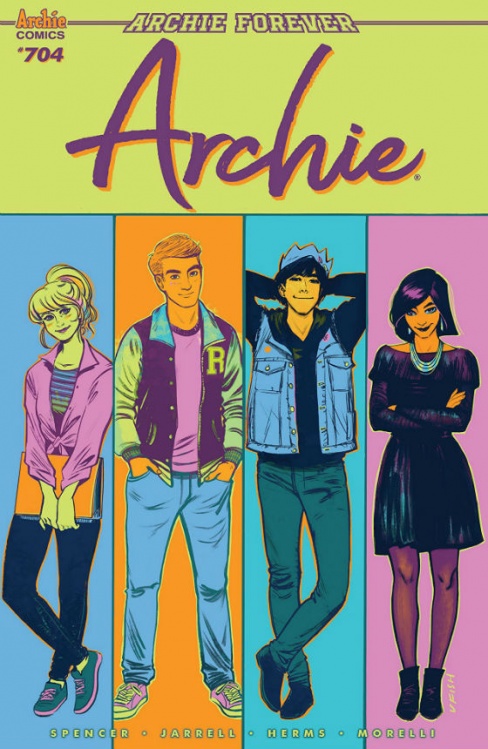
Archie #704
Written by Nick Spencer
Illustrated by Sandy Jarrell
Lettered by Jack Morelli
Colored by Matt Herms
Reviewed by Michael Govan
America has known many great heartthrobs. James Dean. George Clooney. Archie Andrews…I guess. Every now and then, I kind of get it. Under Mark Waid’s pen, the romance was pretty believable. I could understand how Betty and Veronica would both fall for Riverdale’s favorite ginger. I could understand why some other girls would find him cute. If you look at his current television counterpart, you can see why girls would want him. Maybe not a teacher…but sure, fine.
That’s just every now and then though. Most of the time, I have no idea why girls would fall all over the guy and in “Archie” #704, they are definitely falling over him. Archie has to hide his secret girlfriend, Sabrina the Witch, while competing in a The Bachelor style game show set up by his two ex-girlfriends, Betty and Veronica. I mean, come on. Even Wilt Chamberlain on his best day didn’t see that kind of action.
The romantic entanglements have always been an element of “Archie” but when it’s the focus, sometimes it can go overboard. This would be one of those times. I would rather see more development go to the much more interesting mystery going on in the background here. However, Jughead’s investigation into the disappearance of Reggie Mantle’s father is hardly touched on in favor of watching girls (implausibly) pine over Archie for the umpteenth time.
Final Verdict: 5.5 – Ladies continue to pursue ‘Archiekins’…for reasons that are beyond me.

“By Night” #11
Written by John Allison
Illustrated by Christine Larson
Colored by Sarah Stern
Lettered by Jim Campbell
Reviewed by Elias Rosner
Illuminating Chet Charles by the light of an otherworldly moon, “By Night” #11 complicates his narrative in order to propel the series into its final issue. With the film completed and the mystery of the mountain, CharlesCo and the Eidolon solved, without this added wrinkle, there would be little else for the final issue to do. It also provides a better insight into the otherworld & its politics, as well as the problems with ego and vengeance, all without losing the fast wit and fun dialog that Allison is known for.
Larson also does a great job of capturing the desolation of the mountain’s corpse while Stern beautifully fragments the past from the present, channeling the dot coloring of old in the past and the more sleek, digital coloring of the present. In fact, the past panels feel like reading an older sword & sorcery comic, even if the paneling is more modern. Campbell’s lettering, while not following suit, still fits the comic well, refusing to overwhelm the artwork and integrating the differences between narration and dialog well onto the page.
The voices, and volume, of the characters come though well and the same is true for the sound effects, when they are present. That said, once Chet Charles is back in the “real world,” the comic loses some of its edge, puttering around with characterization for him and Dr. Gramercy that is only there so we have more reasons to root against them in the finale while simultaneously not giving us enough time with him to really make him a more complex character. There are moments that get close, such as the bottom two panels of page 18, but beyond that, there is little else to go on or to connect with that isn’t either a possibly untrustworthy recounting of events or a bit of rushed characterization.
It’s a small gripe but one which does lessen the impact of the coming finale. Gardt’s actions at the end seem to be framed as if it were a bad thing but, after having seen Chet act, it’s easier to be on Gardt’s side, instead of being left with an ambiguous decision of who is best to root for. Still, all the part of the issue come together to form a fun, funny and still tense adventure that has me waiting for the finale next month and the hope that we’ll get to see more of the Owl creature from the monster city hall.
Continued belowFinal Verdict: 7.0 – A good penultimate issue that is hampered by some thin characterization and set-up but still retains the charm and magic of the rest of the series.
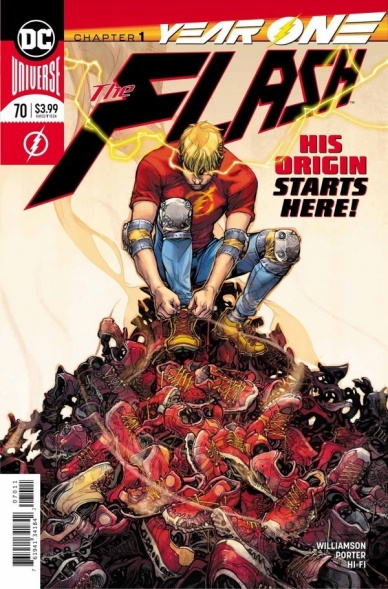
The Flash #70
Written by Joshua Williamson
Illustrated by Howard Porter
Colored by HI-FI
Lettered by Steve Wands
Reviewed by Niklynn Dunn
Joshua Williamson continues his long run on “The Flash” with ‘Year One,’ which begins here. This issue doesn’t add too much about Barry Allen’s origin, but it does set up a good jumping on point for new readers, especially ones that are a fan of The Flash tv show, while also continuing the overarching storyline of the series.
As far as the art, we all need to be grateful for Howard Porter. DC, and superhero comics in general, unfortunately sometimes has a typical house style and Porter’s art is leagues above that. Just look at his art any time Barry is on the move. His art has a flow to it and obviously on “The Flash,” that’s what you want. The panel layout helps with the flow too and Hi-fi’s colors put Porter’s art in top gear by being crisp and dynamic. And since the origin aspect of the story might be a retread to some readers, at least those readers will get to feast their eyes on good art.
Overall, “The Flash” #70 is a solid comic and the cliffhanger is a good setup for what is to come next in this series. The prospect of seeing young Barry in action is exciting too.
Final Verdict: 7.9 – This issue is nothing mind-blowing, but it’s a good setup for what is to come next and is a good jumping on point for new readers since it tells Barry’s origin.

Infinite Dark #6
Written by Ryan Cady
Illustrated by Andrea Mutti
Colored by K. Michael Russell
Lettered by Troy Peteri
Reviewed by Gregory Ellner
With the fall of Entropy’s Hand comes another, distinctly different problem: people themselves. Unlike the eldritch entity in the black (if it in fact exists), the Acolytes are able to take up the slack. Ryan Cady is able to bring together a hectic, overworked, stressful environment on the Orpheus after the end, using brief moments with random civilians alongside repeated transmissions presented entirely without context. Parallels to modern life in 2019 are extremely obvious, but unlike some other stories, the parallels are not enough to truly draw readers out of the story altogether. In a sense, the fall of Entropy’s Hand led to a situation that is far worse, and tension only continues to rise as the second arc continues.
Andrea Mutti’s artwork is a lot more detailed than it sometimes becomes, with intense close-ups and views of large groups of people that are both given far less of the stylization more common of his penciling. On account of the corpse-like nature of the Acolytes in direct contrast against the more normal people acting in heroic opposition, the former’s more blurred, disgusting facial features are used to highlight how clean Deva and her compatriots are, at least in terms of the morals of trying to save the station from self-destruction (whether societally or physically).
K. Michael Russell’s colors are, as ever, intricate and indicative of the mood of a given scene. Cool blues show the isolation of the black and certain calmer areas of the void station, whereas harsher, disturbed yellows, browns, and oranges help to show the chaos of the people from what they had just learned piecemeal.
In all, the story seems to be shaping up quite nicely, with enough mystery to keep readers moving forward.
Final Verdict: 7.0- Though the real-life parallels may disturb some readers, “Infinite Dark” continues to be an interesting read with a new, more personal focus to its science fiction horror setting.
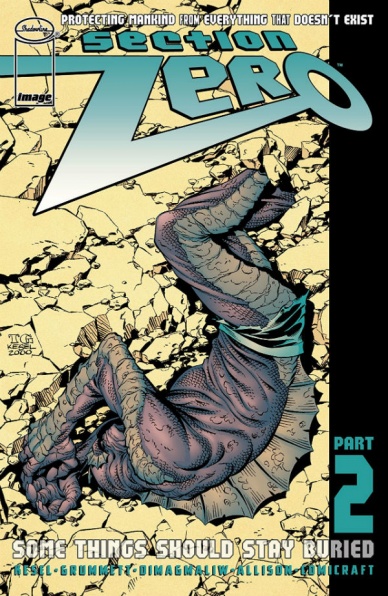
Section Zero #2
Written by Karl Kesel
Illustrated by Tom Grummett
Colored by Ben Dimagmaliw, with Grace Allison & Jeremy Colwell
Lettered by Comicraft’s Richard Starkings
Reviewed by Gustavo S. Lodi
“Section Zero” caters to a very specific audience and, while the series and this issue are noticeably strong, your mileage may vary depending on how aligned you are with that target audience to begin with. Utilising a definitely late-nineties aesthetics, and a narrative style that is anything but the decompressed movement dominant on today’s comics, this one is quite interesting.
Continued belowNarrating the adventures of a group of scientists and explorers, in the midst of some truly outlandish situations, “Section Zero” borrows a lot from series like “Fantastic Four” and “Challengers of the Unknown,” down to its desire to focus on family dynamics and personal interplay. It steers clear from more recent interpretation on that modus operandi (like the ones founds in “Planetary”), to some truly nostalgic comic experience.
The art by Grummett was a perfect fit for this narrative. The artist himself evokes a certain time in comics, when large team dynamics and relentless action left character development to occur in-between the moments, and not on special issues dedicated to that. He has a certain flair to present new designs (for humans and best-like characters alike) that really take the spotlight of “Section Zero.” The relatively quieter moments are also good, even though some characters facial expressions will look a bit derivative – some characters seems straight out of older publications.
The general plot by Kessel is an engaging one, with a group of disparate individuals being pulled together to investigate something for the greater good, different skills being applied to different situations. It is on his pacing that Kesel suffers a bit, with some many elements being introduced at once that even fans of a faster-paced narrative might ask for a slowdown.
All in all, “Section Zero” harkens back to a time in comics when faster meant better and character evolution was literally integral to plot evolution, and not the other way around. It works for most of it, but in trying to reach that speed so often, it stumbles at times.
Final Verdict: 7.2 – Compelling, beautiful and engaging, “Section Zero” deserves its audience’s attention, if for nothing else for trying to do something different on today’s market place.
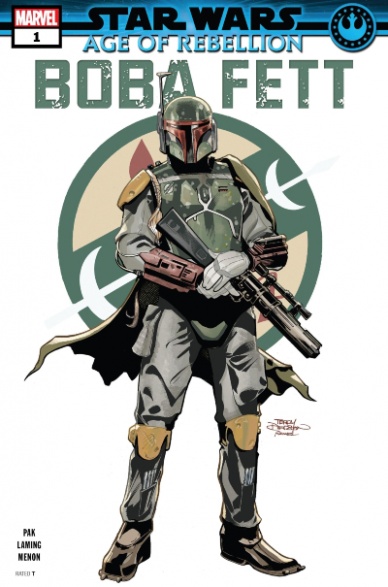
Star Wars: Age of Rebellion – Boba Fett #1
Written by Greg Pak
Illustrated by Marc Laming
Colored by Neeraj Menon
Lettered by VC’s Travis Lanham
Reviewed by Chris Egan
Greg Pak writes a dark tale that is built off the intriguing mystique fans felt about the Mandalorian when he first graced the big screen in The Empire Strikes Back. Although there have been many stories expanding on the life and times of Boba Fett, both canon and non-canon ‘Legends,’ this one-shot takes us back to a time when the ‘best bounty hunter in the galaxy’ was just that, with little other information given. Pak ensures that Fett’s reputation precedes him, with every other character that interacts with him or mentions him boosting that rep with how they speak to him or react to the knowledge that he is in the area, or that they may come face to face with him. There is a slight sense of humor to the story as well, and fits in perfectly with the dry, and occasionally dark, humor that works so well in most of the films. While Fett is the strong, silent type; his foreboding presence looming over every panel, seeing minor characters fill out the exposition while the title character utters no more than a single sentence in the entire issue comes off as a little funny, and rightfully so.
Laming’s artwork is beautifully detailed and gives us the gritty look of scum and villainy that fans have come to love. He gives us excellent action pieces, as well as soft-spoken moments of underground criminal dealings. Menon’s color work is exceptional, fully fleshing out this dusty backwater planet filled with Rebels, smugglers and bounty hunters. Boba Fett works best when used in dark spaceports or desert worlds, in space western stories. The ‘Man With No Name’ vibes are strong here and the three stars of this creative team have crafted a near perfect story for him. One that leaves plenty of mystery, while showing that he is the master professional he was always hyped up to be.
The best of these new “Age of…” comics are the ones that are accessible to all fans, from those that saw the original film on the big screen in 1977, to those just growing up with the new trilogy and ‘Hunter’s Heart,’ is a perfect example of that.
Continued belowFinal Verdict: 8.5, An exciting and haunting tale of the hunter and the hunted, this small scale Boba Fett story is exactly the adventure he deserves.

Supergirl #30
Written by Marc Andreyko
Penciled by Kevin Maguire
Inked by Sean Parsons
Colored by Chris Sotomayor
Lettered by Tom Napolitano
Reviewed by Alexander Jones
Marc Andreyko and Kevin Maguire’s take on “Supergirl” was founded on the idea that Kara Zor El has carried an intense level of rage since learning baddie Rogol Zaar was responsible for the destruction of Krypton. “Supergirl” #30 is the issue pushing Kara’s angsty to a logical conclusion, hinting towards a kinder and gentler Supergirl coming in future issues. Understanding the next steps of Supergirl’s angst is a great payoff to the beginning of the run. Kara has been acting incredibly impulsive since Andreyko’s run started which has led to a few fun confrontations but also could serve to be jarring for readers looking for a more classic version of the character.
This issue also carries the full reveal of Z’ndr’s secrets to Kara which Andreyko has been building to across a bevy of issues earlier in the series. In the issue, “Supergirl” strives to alleviate the tension with her supporting cast members. Andreyko stretches the Superman premise to the limit and comes back with positive things to say about the franchise and superhero comics in general. These are stories that inspire us to be better and despite an edgy batch of opening issues, Andreyko proves he hasn’t lost sight of Kara’s warm personality.
Kevin Maguire does a great job drawing sleek, expressive pencils that carry a lot of detail. Maguire brings adequate page layouts with big facial expressions and poses. Maguire does a great job capturing the big, dramatic aspects of a scene with the necessary bombast of superhero comics. Following Maguire’s interior work is easy and straightforward but feels rewarding because of the creative layouts and expressions of the characters.
If Andreyko committed to the angsty direction for Kara past “Supergirl” #30, the results could have been disastrous. Thankfully, Andreyko takes the time to track the character progression for Kara with an issue featuring excellent pencils from Maguire. “Supergirl” is a DC Comic willing to take chances and I hope in the future, the title will continue to commit to addressing the fallout from Kara’s behavior while displaying a kinder Kara.
Final Verdict: 8.0 – “Supergirl” #30 addresses a huge character flaw for Kara with a fascinating plot beat.
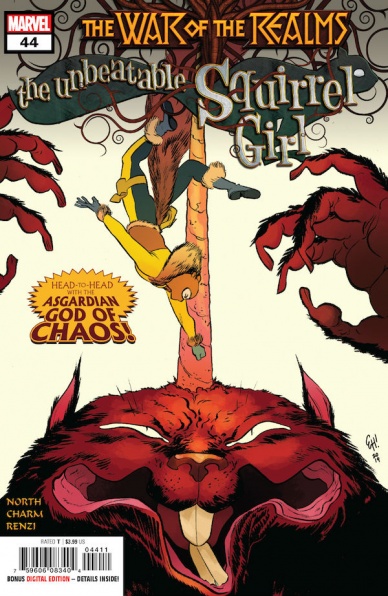
Unbeatable Squirrel Girl #44
Written by Ryan North
Illustrated by Derek Charm
Colored by Rico Renzi
Lettered by Travis Lanham
Reviewed by Matthew Blair
Marvel Comics is neck deep into its massive “War of the Realms” event where the fate of the world is yet again in the balance, and the big question on everyone’s mind is: what’s Squirrel Girl up to?
Okay, so maybe that’s not the question on everyone’s mind, but you’d be surprised at how capable Marvel’s resident squirrel themed super heroine can be. “Unbeatable Squirrel Girl” #44 opens in the frozen north of Canada, where our heroine must team up with the Asgardian deity Ratatoskr, who just so happens to be a giant demonic squirrel god of chaos, in order to defeat an army of frost giants.
Everything that makes Squirrel Girl great is on display in this issue. While she may only be a mere mortal, albeit with the proportional speed and strength of a squirrel, she has no problem going toe to toe with giants and demanding that certain Asgardian squirrel gods of chaos remain on their best behavior. The book even takes time to show the fear and paranoia of everyday people who are simply trying to live their lives amid the chaos of an inter-dimensional invasion.
Ryan North has been working on “The Unbeatable Squirrel Girl” from the beginning of its relaunch in 2015, and it’s clear that he’s having the time of his life. His quick, wordy, and clever dialogue has helped create a Squirrel Girl that is capable, self aware, and full of sass that will leave you chuckling and rooting for her in the same breath. His recaps and dialogue asides at the bottom of each page are an absolute treat and are not to be missed.
The artwork may appear to be cartoonish and simplistic, mostly because it is, but I don’t mean that as an insult. Like the writing, the art style has remained pretty consistent over the last four years and artist Derek Charm, along with colorist Rico Renzi, help create a story that is easy to follow, but remains expressive and engaging.
Final Verdict: 9.1 – A funny, self aware, and surprisingly deep story that promises to be a lot of fun and is perfect for readers of all ages.






